Swing Trading Strategies for Bulls, Bears, and the Markets In-Between

When trading, you often hear the words bull markets, bear markets, and in-between Markets. These three distinct long-term trends shape the overall market environment, each demanding a tailored swing trading strategy.
Bull markets, characterized by sustained price increases, are often seen as the "golden age" for swing traders. With the overall trend pushing prices upwards, identifying and profiting from buying opportunities becomes more achievable. However, even in these seemingly favorable conditions, there are pitfalls to avoid.
Conversely, Bear markets, defined by price declines, present a unique challenge. The natural "buy and hold" approach often fails in a downtrend. Swing traders must adapt their strategies to navigate this environment and potentially profit even when the market sentiment is bearish.
But what about the periods in between these well-defined bull and bear trends? This seemingly neutral territory, often characterized by sideways price action, can also be fertile ground for swing traders. Swing traders can develop strategies to exploit their present opportunities by understanding the specific characteristics of these neutral markets.
Throughout this discussion, we'll explore each scenario's defining characteristics, discuss effective swing trading strategies for each scenario, and uncover potential pitfalls to avoid. By understanding how these market phases influence trading strategies, swing traders can equip themselves with the knowledge to navigate the ever-changing market landscape and capture profits across different market conditions.
So, Let's Start with the First One,
Swing Trading in Bull Markets
Bull markets, characterized by rising prices, present a fertile ground for swing traders. This leads to comparatively Easier Profits.
In a bull market, the overall trend is up. This makes it statistically easier for swing traders to identify and profit from buying opportunities. As prices generally appreciate, buying and holding a stock for a short period has a higher chance of success than a bear market.
But there are some Challenges to Consider.
As the bull market progresses, prices tend to climb. This means potential higher entry points for swing trades are making them more expensive. Swing traders must carefully consider the risk-reward ratio to ensure the potential profits justify the higher entry price.
The bullish sentiment of a bull market can lull traders into a false sense of security. It's easy to fall into the trap of neglecting fundamental analysis and chasing any stock that seems to be going up. Discipline and thorough research are still crucial during bull markets to identify stocks with strong fundamentals and healthy growth potential.
And then there is The Leverage Trap.
Leverage, such as margin trading, can magnify profits in a bull market. However, it also amplifies losses. Swing traders should carefully consider their risk tolerance before using leverage. It's a risky strategy that can quickly turn small losses into significant ones if the market turns against you.
Alright,
So,
What are the Strategies for Bull Market Swing Trading?
Experienced Swing Traders employ Trend-Following Strategies for Bull Markets.
How? Let's See,
Since bull markets involve a sustained upward trend, using moving averages to identify and capitalize on that trend becomes attractive. A common strategy is to enter a long position (buying) when the price crosses above a short-term moving average and exit when it falls below.
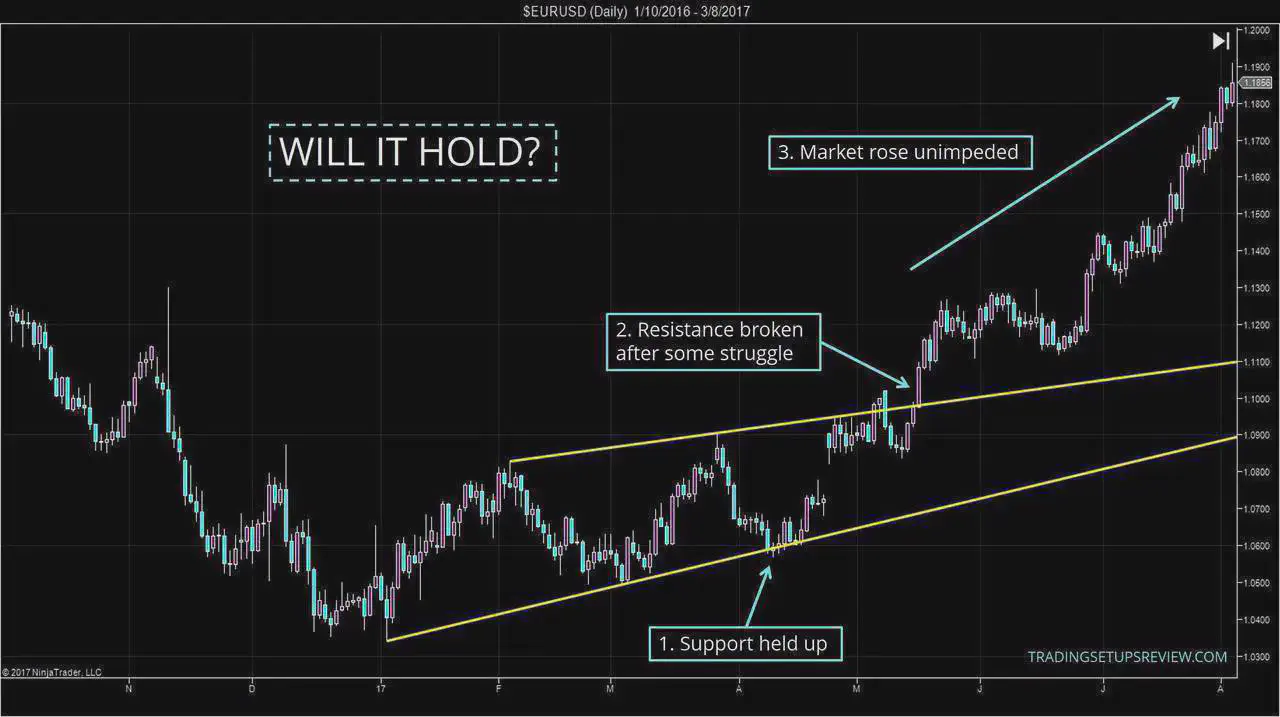
Another Trend Strategy is following Breakouts,
Bull markets often experience periods of consolidation, followed by price breakouts to new highs. Swing traders can identify these breakouts using technical indicators or chart patterns and enter long positions to capture the subsequent price advance.
And what kind of Chart Patterns?
Patterns like ascending triangles with rising trendlines signal a potential uptrend continuation. A swing trader might enter a long position near a breakout above the triangle's upper trendline.
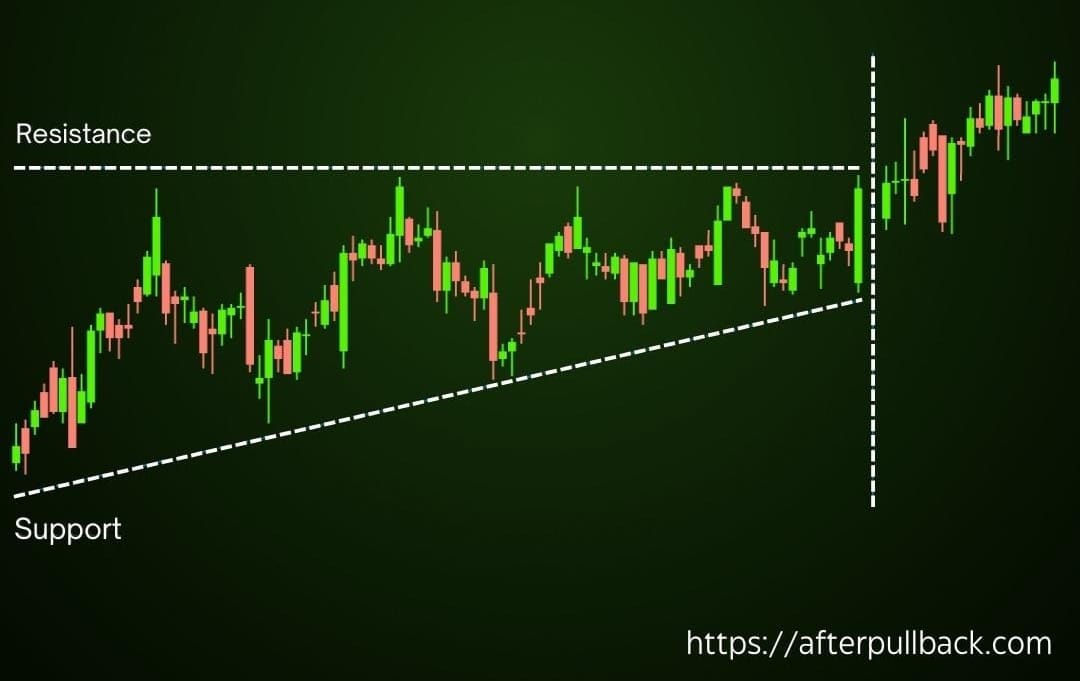
Similarly, Patterns like Flags and Pennants: These consolidation patterns within an uptrend suggest a brief pause before the uptrend resumes. Swing traders can enter long positions near a breakout above the flag or pennant's upper resistance line.
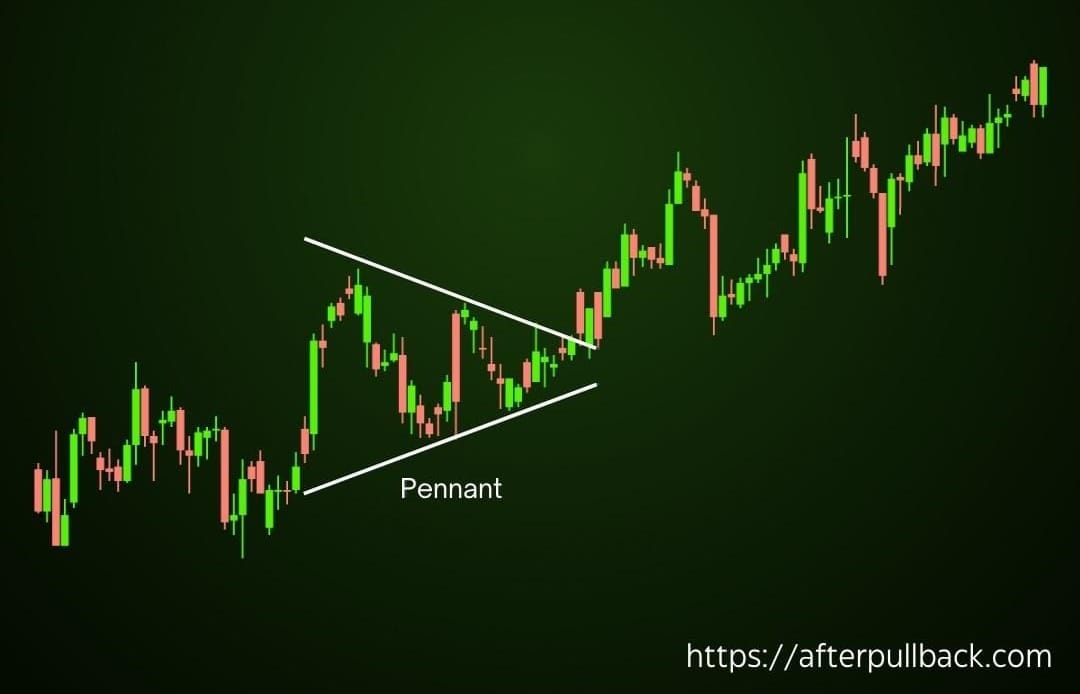
Swing Traders also use Technical Indicators like the Relative Strength Index (RSI). The RSI is a momentum indicator that can help identify potential overbought or oversold conditions. When the RSI dips below a certain level (typically 30) in a bull market, it might indicate a temporary dip within the uptrend, presenting a buying opportunity for swing traders.
But wait,
Although Bull markets offer Significant trading Opportunities, some Important Considerations must still be made while trading.
The First One is to Avoid Chasing Prices. While a bull market can strongly urge you to enter the trade, avoid chasing prices that have already run up significantly. Look for healthy entry points with a good risk-reward ratio.
Also, always look for the
Confirmation Signals.
Don't rely solely on one indicator. Use a confluence of technical indicators or chart patterns to confirm entry and exit signals, especially in a bull market where false breakouts can occur.
And
Do Take Profits and always place Stop Loss
Even in a bull market, profits should be taken regularly. Letting profits run can be tempting, but prices can reverse course quickly. Setting stop-loss orders helps limit potential losses if the price falls against your position. Remember, even bull markets experience corrections.
Remember,
Bull markets don't last forever. Be prepared to adjust your strategies when market conditions change. Focus on Risk Management: Sound risk management practices like proper position sizing and stop-loss orders are essential in any market, including bull markets. Last, Discipline is Key. Don't get caught up in the euphoria of a bull market. Maintain discipline, conduct your research, and stick to your trading plan.
Swing Trading in Bear Markets
In a bull market, the natural tendency is to buy and hold a stock as the price climbs. This "buy and hold" strategy generally doesn't work in a bear market. Equity prices are inherently more likely to fall than rise significantly over time. Buying a stock with the expectation it will eventually recover can lead to significant losses if the downtrend persists.
So, which strategies should be used in Bear Markets?
Several strategies can help swing traders navigate a bear market and potentially profit even when the overall market trend is down.
One of these strategies is Short-Selling (if available):
In some brokerage accounts, you can borrow shares of a stock and sell them short, profiting if the price goes down. This magnifies potential profits compared to buying and holding puts (explained below). However, short selling is a complex strategy with significant risks; not all brokers allow it.
Put options grant the right, but not the obligation, to sell a stock at a certain price by a certain time. In a bear market, swing traders can buy put options on stocks they believe will decline in value. If the stock price falls, the put option increases in value, allowing the trader to profit. This limits the potential loss compared to short selling because the maximum loss is the premium paid for the put option.
So, how do the traders use this Short Selling?
Yes, By Trend-Following Strategy, again.
How? Let's see,
Similar to bull markets, swing traders can use moving averages to identify the downtrend and position themselves accordingly. Here, they would enter a short position (selling borrowed shares or buying puts) when the price falls below a short-term moving average and exit when it rises above.
Similarly,
Opposite to breakouts in bull markets, bear markets often see breakdowns below support levels. These breakdowns can be identified by either.
Technical Indicators like moving averages and the Relative Strength Index (RSI) can suggest a breakdown is imminent. For example, a price falling below a short-term moving average that previously acted as support or an RSI dipping below 30 (oversold territory) could suggest a breakdown is imminent.
Or,
Recognizable visual patterns on charts can also signal breakdowns. Common examples include head and shoulders patterns, where a peak followed by two lower peaks suggests a potential breakdown below the support level, and descending triangles, where the price consistently breaks through the lower trendline, indicating a possible downward move.
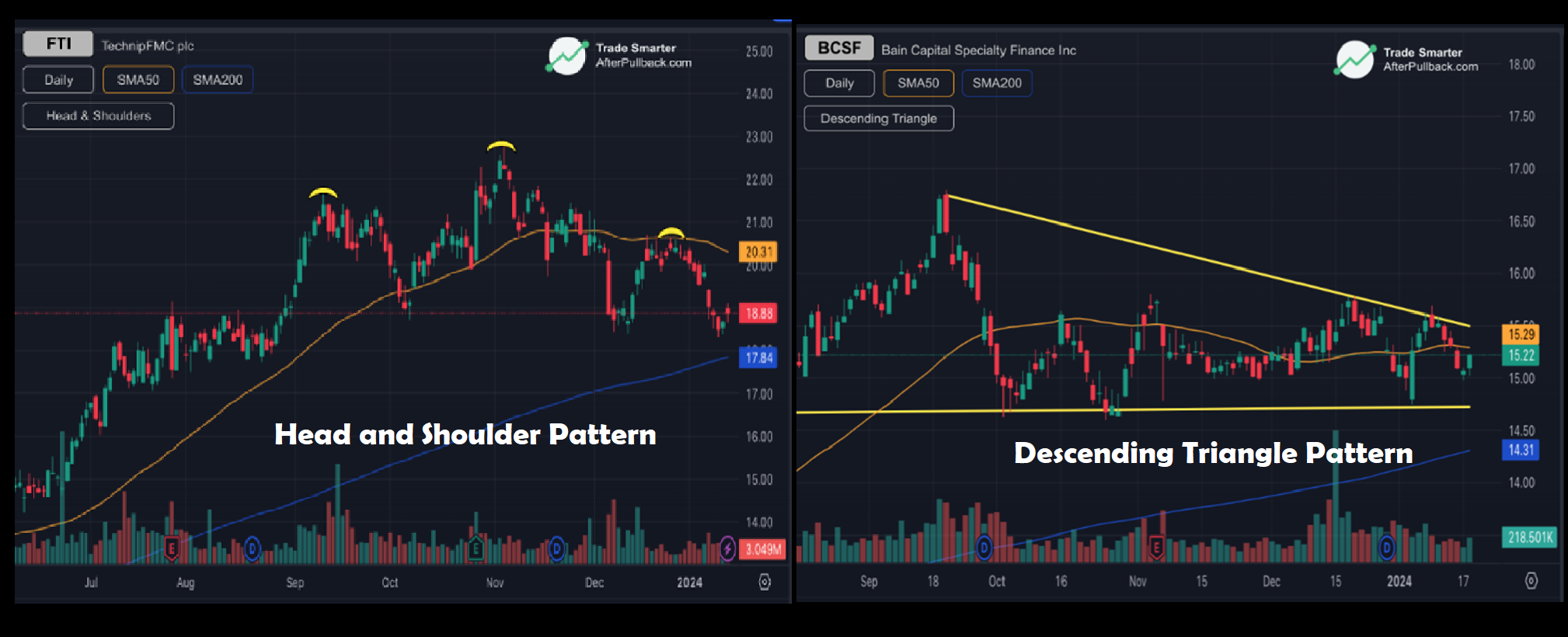
Once a breakdown is identified, swing traders can enter short positions. This involves borrowing shares of a stock, selling them immediately, and hoping to repurchase them later at a lower price to pocket the difference as profit.
Mean Reversion Strategies
However, bear markets aren't all doom and gloom. There can be temporary price bounces, even within a downtrend. Swing traders can leverage mean reversion strategies to capitalize on these short-term opportunities.
The RSI and other indicators can help identify when a stock might be oversold. This suggests the price may be due for a temporary correction upwards. Swing traders can enter short-term long positions during these oversold periods, profiting from the price increase before the downtrend resumes.
Swing Traders can also leverage price channels to Trade downtrends.
During bear markets, prices often trade within a descending channel. This channel connects the price lows and highs, with a downward slope reflecting the overall downtrend. Swing traders can identify these channels and look for opportunities to enter short positions near the channel's upper resistance line. This anticipates a continuation of the downtrend as the price will likely be rejected at the resistance level and fall back towards the channel's bottom.
Swing Trading is for in-between/neutral market conditions.
Between bull and bear markets lies a period where the market lacks a clear directional trend. This can frustrate swing traders who capitalize on strong upward or downward movements. But this period can also give you some opportunities.
Why?
Because Volatility is your Friend, neutral markets often experience two-way Volatility, fluctuating prices within a defined range. This allows swing traders to profit from short-term price swings in both directions.
Also, Sideways markets have
Lower Risks associated with them. Compared to the strong trends of bull and bear markets, sideways markets generally involve lower overall price movements. This can translate to lower risk for swing traders, as sharp price swings against your position are less likely.
And therefore
Finding High-Probability Setups is relatively easy. Technical analysis tools like chart patterns and indicators are often more reliable in sideways markets. Since the price action is less erratic, swing traders can identify higher-probability trade setups with a better chance of success.
So,
What are the strategies for neutral markets and swing trading?
One of the most common strategies for swing traders operating in sideways markets is
Range Trading.
In this strategy, Traders Identify trading ranges using technical indicators like Bollinger Bands or support and resistance levels. These ranges define a price zone where the asset has been trading for some time.
Swing traders can then look for entry points near the edges of the range. Buy orders can be placed near support in anticipation of a bounce, and sell orders can be placed near resistance in anticipation of a pullback. The goal is to capture profits from these short-term price swings within the defined range.
And how do we identify the Trading Ranges?
By looking for Consolidation Patterns.
Consolidation patterns take various shapes, each offering clues about the potential future direction of the price. Some common consolidation patterns swing traders look for include:
Triangles: These patterns form when the price action gets squeezed between converging trendlines, either ascending (bullish) or descending (bearish). A breakout above the resistance in an ascending triangle or below the support in a descending triangle suggests a potential trend continuation.
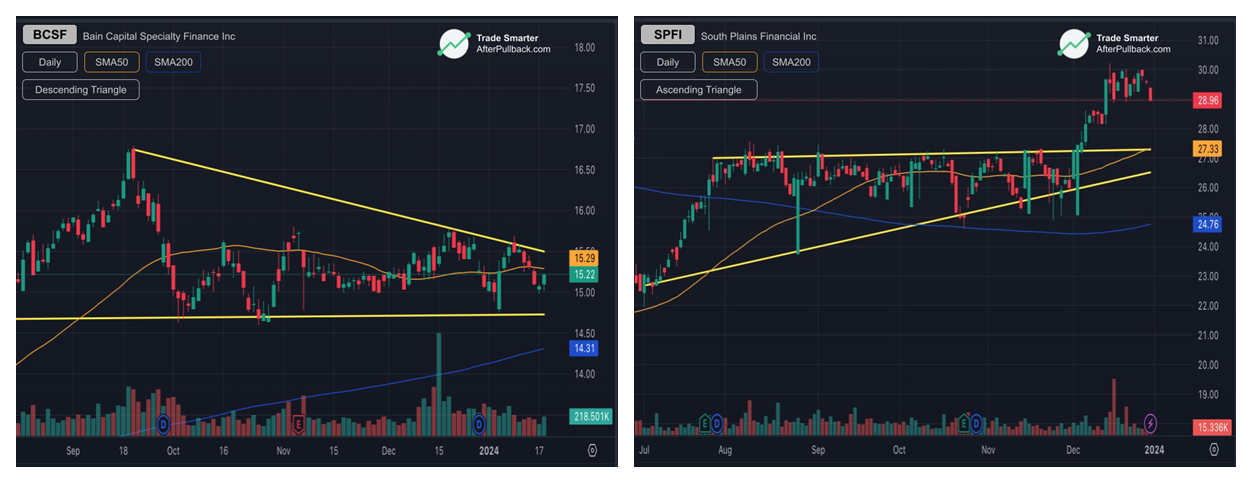
And Similar to bull markets, Flags and Pennants can also show short-term consolidation patterns within an established uptrend or downtrend.
So, how do we trade based on these patterns?
These consolidation patterns allow swing traders to position themselves for the anticipated price movement.
Here's how:
Once a swing trader identifies a consolidation pattern, they wait for a breakout, a decisive move by the price above the resistance level in an uptrend pattern or below the support level in a downtrend pattern. This breakout suggests a continuation of the trend, and swing traders can enter positions in line with the breakout direction.
But Be Vigilant!
While breakouts are an excellent initial indicator, swing traders should rely on something other than them. Using additional technical indicators, such as increased volume or confirmation from other indicators, can strengthen the breakout signal and increase confidence in the trade.
And there is another approach as well, which is
Sector Rotation.
Even in a directionless overall market, some sectors outperform due to specific economic factors or news events.
Swing traders can analyze sector performance and identify sectors that are trending. They can then focus their trading efforts on stocks within those sectors, potentially profiting from their relative strength.
Conclusion
Swing trading offers opportunities to profit in various market conditions, from bull markets characterized by rising prices to bear markets defined by price declines and even neutral markets lacking a clear direction. By understanding the unique characteristics of each market phase, swing traders can capture profits across different scenarios.
Remember, sound risk management practices and a disciplined approach are crucial for success in any market condition. So, stay informed, adapt your strategies, and trade with caution!
Trade Smarter!





